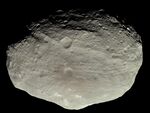Astronomy:2011 WL2
| Discovery[1] | |
|---|---|
| Discovered by | LINEAR |
| Discovery site | Lincoln Laboratory ETS |
| Discovery date | 16 November 2011 |
| Designations | |
| 2011 WL2 | |
| MPO 246965 | |
| Minor planet category | Apollo  NEO, PHA |
| Orbital characteristics[2] | |
| Epoch 13 January 2016 (JD 2457400.5) | |
| Uncertainty parameter 2 | |
| Observation arc | 386 days (1.06 yr) |
| |{{{apsis}}}|helion}} | 1.3833510 astronomical unit|AU (206.94636 Gm) |
| |{{{apsis}}}|helion}} | 0.7723798 AU (115.54637 Gm) |
| 1.0778654 AU (161.24637 Gm) | |
| Eccentricity | 0.283417 |
| Orbital period | 1.12 yr (408.74 d) |
| Average Orbital speed | 28.10406 km/s |
| Mean anomaly | 336.9187° |
| Mean motion | 0° 52m 50.734s /day |
| Inclination | 14.12974° |
| Longitude of ascending node | 212.9462° |
| 88.83006° | |
| Earth MOID | 0.00141998 AU (212,426 km) |
| Jupiter MOID | 3.83997 AU (574.451 Gm) |
| Physical characteristics | |
| Dimensions | 190–420 m[3] |
| Absolute magnitude (H) | 20.8[2] |
2011 WL2 is a small asteroid, classified a near-Earth object and potentially hazardous asteroid of the Apollo group.
Orbit
The orbit of 2011 WL2 makes it a Potentially Hazardous Asteroid (PHA) whose orbit has been determined with about 1 year of observations. The orbit of 2011 WL2 is somewhat uncertain, but could pass a distance of 0.001635 AU (244,600 km) from the Earth in the year 2087.[2] Only the nominal (best-fit) orbit shows a passage this close. The uncertainty region is still somewhat large due to a short observation arc. For comparison, the distance to the Moon is about 0.0026 AU (384,400 km). 2011 WL2 appears on the list of PHA close approaches issued by the Minor Planet Center (MPC), with the next close approach in the year 2038.[4]
The Jupiter Tisserand invariant, used to distinguish different kinds of orbits, is 5.7.[2]
References
- ↑ "2011 WL2". Minor Planet Center. 2012-12-06. http://www.minorplanetcenter.net/db_search/show_object?utf8=%E2%9C%93&object_id=2011+WL2.
- ↑ 2.0 2.1 2.2 2.3 "JPL Small-Body Database Browser: 2011 WL2)". Jet Propulsion Laboratory. http://ssd.jpl.nasa.gov/sbdb.cgi?sstr=2011%20WL2;old=0;orb=0;cov=0;log=0;cad=1#cad. Retrieved 1 April 2016.
- ↑ "ABSOLUTE MAGNITUDE (H)". NASA. http://neo.jpl.nasa.gov/glossary/h.html.
- ↑ "PHA Close Approaches To The Earth". Minor Planet Center. http://www.minorplanetcenter.net/iau/lists/PHACloseApp.html. Retrieved 2015-05-29.
External links
- 2011 WL2 at the JPL Small-Body Database
| Preceded by 2005 WY55 |
Large NEO Earth close approach (inside the orbit of the Moon) 26 October 2087 |
Succeeded by 2007 YV56 |




